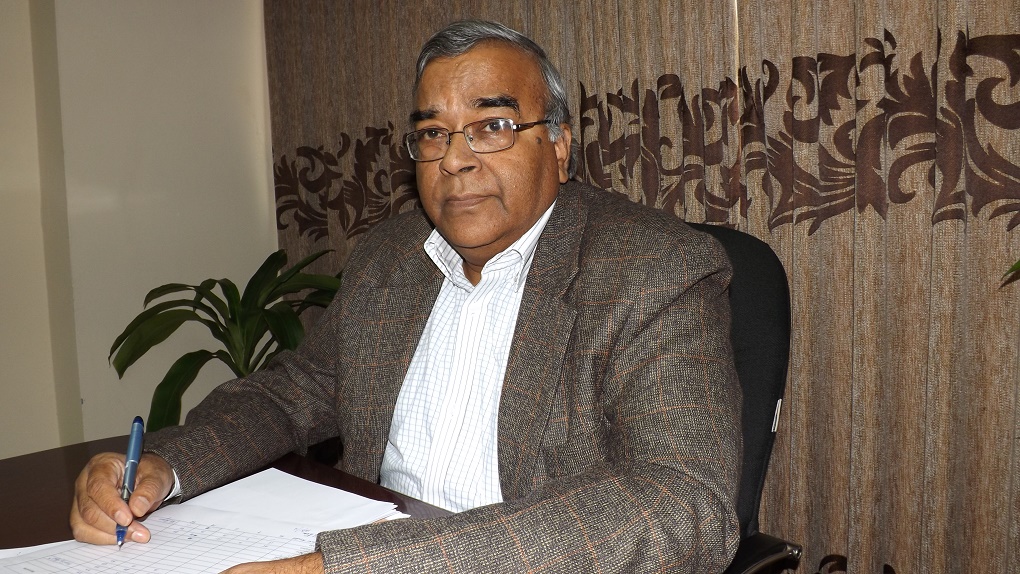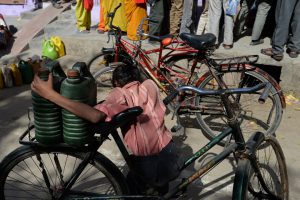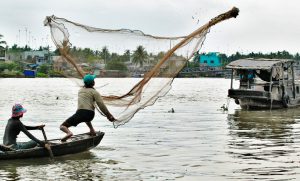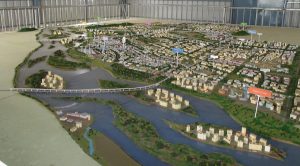Abu Saleh Khan is the Deputy Executive Director of the Dhaka-based think tank, the Institute of Water Modelling (IWM). He has spent over 30 years planning and managing water resources, and served on the Bangladesh Water Development Board in various capacities, including the design of major flood control, irrigation and drainage projects. Since 1990 he has been engaged in the use of mathematical hydraulic models to improve water-related environmental studies Saleh was involved in Teesta Barrage Project for more than 10 years.
Abu Saleh Khan spoke with thethirdpole.net about the poor water flow of rivers in Bangladesh during the dry season and how it affects the livelihood of local communities and biodiversity.
According to the Joint River Commission established between India and Bangladesh, the water flow of the transboundary Teesta River on 22 March 2015 was 232 cubic feet per second (cusecs). This is almost one-twentieth of the flow in 1980, 4,494 cusecs.
Another major transboundary river, the Padma (called the Ganga in India) has also experienced a decline in flow, though more recently. According to the Bangladesh Water Development Board, the average minimum flow of the Padma River has been 22,300 cusecs over the last 12 years. But in May 2011 there was a drastic drop, down to 3,100 cusec. While data does not exist for all the transboundary rivers, overall anecdotal evidence indicates that such declines in water flow are experienced across almost all of them.
Rafiqul Islam (RI): Bangladesh experiences a rapid decline of water flow in its rivers during the dry season every year. What kind of problems will this create it the future?
Abu Saleh Khan (ASK): Bangladesh is a delta. The low water flow in trans-boundary rivers during the dry season poses different kinds of adverse impacts on the tidal areas of the country’s coastal region and non-tidal areas. Due to poor water flow in rivers, salinity intrusion will go up in the tidal zones of Bangladesh, destroying the freshwater sources over time. As a result, scarcity of sweet water will be severe in the southwestern region of the country like Khulna and Satkhira districts. Agriculture will face a major setback while the biodiversity will be affected in the areas. Freshwater biodiversity will transform into saltwater biodiversity. Saltwater species and plants will be adopted there. But scarcity of drinking water and disruption of crop production will be major problems. The livelihood of impoverished communities will also be affected severely.
RI: And what about the non-tidal areas of the country?
ASK: In non-tidal areas water connectivity will decline as the water flow declines. Due to the lack of navigability in rivers, people have now become dependent on roads. They hardly use water routes. Water pollution will also emerge as a new problem in Bangladesh. You know people dump untreated waste into the rivers. As water flow of the rivers flushes out the waste, we normally do not see the pollution. But when the river water flows decline rapidly, water pollution will intensify. Despite having a regulatory body, the Department of Environment supposed, Bangladesh is yet to check water pollution effectively. Many big industries are located on riverbanks and they are disposing untreated waste into the rivers. Water pollution is now visible only in Dhaka surrounding rivers like Buriganga and Turag. But it will be more severe in other areas of the country after 25-30 years because of poor water flow in the rivers.
RI: You know many people are being displaced in Bangladesh each year due to extreme climate events. Do you find any link between low water flow in rivers and internal migration?
ASK: Bangladesh faces trouble during dry season. Sediment is being deposited in the rivers for lack of water flow. The sediment intensifies riverbank erosion during the monsoon, claiming houses and arable land of local people and forcing them to be displaced. The government of Bangladesh has already taken steps to dredge the country’s major rivers to ensure navigability of the rivers. It should take other engineering measures to resolve the sedimentation problem.
You know many people are also being displaced from the southwestern region of the country. We call it migration, and it affects hundreds of thousands of people. People are not able to cultivate crops in highly saline-prone areas. Marginal people use river water for their household and drinking purposes. If there is no sweet water in rivers of the coastal areas, people will migrate to other places in coming days. Salinity intrusion will increase in the coastal region and sea level will rise. We understand all the things. But, we must adopt climate-tolerant [crop] varieties to address the upcoming situation.
RI: Other than navigation, salinity and sediment deposits, how else does this problem affect the lives of impoverished communities in Bangladesh?
ASK: In northern Bangladesh, many people are involved in fishing from rivers. If water levels decline sharply in the rivers in the coming days, the fisher community will lose their occupation. You know that poor people catch fish from rivers to meet their household demand, so they will not only lose their livelihood, but they will suffer from malnutrition. For them it will be a double tragedy.
Low water flows will also affect wetlands. You know that the rivers have connectivity with the wetlands, the breeding grounds of fish. If rivers and wetlands dry up, groundwater level will decline for lack of surface water. So, the famers will be forced to extract underground water more to supplement irrigation, increasing the cost of crop production.
RI: Is this hypothetical, or are there already examples of this?
ASK: If you go to the Department of Fisheries, you can know that many fish species, particularly small fish, have already disappeared from many rivers. I do not know whether it happens for lack of water flow in the rivers or not. But, fish from rivers and natural wetlands are becoming more expensive. Now fish found in the market come from fish farms.
RI: How can Bangladesh mitigate these problems?
ASK: Bangladesh must survive. If water levels rapidly decline in rivers you cannot fight with a big upstream neighbour like India for water. It is not a practical solution. The water level in rivers is not only declining here but also declining in upstream countries. They may take steps to divert water from trans-boundary rivers, but we must look towards how we can get water from upper countries. Now Bangladesh is trying to start basin-wide water management in the Ganga, Brahmaputra and Meghna (GBM) basins involving other countries.
There is no alternative to signing agreement with India. Bangladesh has 57 trans-boundary rivers. Of them, it shares 54 transboundary rivers with India and three rivers with Myanmar. Bangladesh has signed an agreement with India over the Ganga. I think it should ink deals with India over every trans-boundary river to keep our rivers alive. We must ensure the water required to sustain biodiversity of river and to maintain its navigability.
Many people question how we will ensure it. If you sign a deal with India to only get water, it will not bring any fruitful result. The agreement must be a broader one. Now we are talking about regional interconnectivity and shipping. All the agreements must be brought under an umbrella. If we give India a navigation route to ply its water vessels and India will get benefit from it, of course, it will release water to Bangladesh. If you say that you will only sign a ‘water agreement’, I can guarantee you that it would not be functional. Now we are talking about regional power grid connectivity. If we can do it, why shouldn’t we be able to establish the regional water connectivity?








